In the world of cryptocurrencies, two digital titans stand tall as the OGs (Original Gangsters): Bitcoin and Monero.
In recent years, the crypto space has seen a proliferation of flashy and novel digital assets with smart contracts, NFTs and a general shift to Proof of Stake (PoS) consensus mechanisms. Bitcoin and Monero, on the other hand, harken back to the old-school days of Proof of Work (PoW) and cypherpunk values by prioritizing privacy, security and decentralization above all else.
Before Bitcoin and Monero entered the scene, a group of privacy-minded individuals known as cypherpunks laid the ideological foundation for cryptocurrencies. Their vision was clear: a world where personal privacy was paramount and financial transactions were censorship-resistant. Both Bitcoin and Monero have faithfully adhered to these principles but Monero has gone the extra mile. Both Bitcoin and Monero still retain the classic pseudoanonymity that wallet addresses provide and as such they are the torchbearers of the cypherpunk revolution.
While Bitcoin's transactions are pseudonymous, meaning they are not directly linked to real-world identities, the blockchain's transparency allows for traceability.
Monero, on the other hand, takes privacy to a whole new level. Launched in 2014, Monero is designed to be truly private and untraceable. Unlike Bitcoin, Monero transactions are confidential, obfuscating sender, recipient and transaction amounts through advanced cryptographic techniques like ring signatures and stealth addresses.
This commitment to privacy has earned Monero a reputation as the cryptocurrency of choice for those seeking financial anonymity. It's the OG crypto for individuals who prioritize personal privacy in an era where data surveillance is increasingly prevalent.
In this Monero vs. Bitcoin comparison article, we aim to provide a solid understanding of the choices they present to users.
Monero. vs. Bitcoin: An Overview
Here's a handy table that compares Monero and Bitcoin across a range of verticals:
| Feature | Monero | Bitcoin |
|---|---|---|
| Speed | Monero transactions are typically faster due to shorter block times (approximately 2 minutes) | Bitcoin transactions may take longer to confirm due to 10-minute block times |
| Fees | Monero fees are generally lower and more predictable due to dynamic block size adjustments | Bitcoin fees can vary widely and tend to rise during network congestion |
| Scalability | Monero has better scalability prospects than Bitcoin due to its dynamic block size and ongoing efforts to improve scalability | Bitcoin faces scalability challenges, with a fixed block size and ongoing debates on how to address this issue |
| Mining | Monero uses the RandomX algorithm, which is ASIC-resistant and designed for CPU/GPU mining, fostering a more decentralized network | Bitcoin uses the SHA-256 algorithm, which is ASIC-dominated, making it more centralized in terms of mining power |
| Privacy | Monero offers strong privacy features, including confidential transactions and ring signatures, making it difficult to trace transactions | Bitcoin transactions are pseudonymous and while some privacy solutions exist, they are not as strong as Monero's privacy features |
| Use Cases | Monero is often preferred for privacy-conscious transactions and has use cases in industries where anonymity is essential | Bitcoin is primarily a digital store of value and is commonly used for investment and as a digital gold |
| Development | Monero has an active development community that focuses on privacy and security improvements | Bitcoin is primarily a digital store of value and is commonly used for investment and as a digital gold |
What is Bitcoin?
Bitcoin is a decentralized digital currency created in 2009 by an anonymous entity or group using the pseudonym Satoshi Nakamoto. Bitcoin transactions are verified and added to the blockchain through a consensus mechanism known as proof of work. This process involves miners using computational power to solve complex mathematical puzzles and in return, they are rewarded with new Bitcoin(s) (subsidy) and transaction fees (rewards). Bitcoin's proof of work system ensures the security and integrity of the network.
Bitcoin's old-school charm lies in its simplicity and robustness. It's a store of value that's been tried and tested, with a limited supply of 21 million coins, disinflation built into the protocol level and most likely will become deflationary in the future. Its adoption has grown steadily over the years, attracting both individual investors and institutional players.
To learn more, check out our extensive Bitcoin guide.
What is Monero?
Monero is a cryptocurrency known for its robust focus on privacy. Unlike traditional cryptocurrencies, Monero transactions are designed to be confidential, obscuring key transaction details such as the sender's identity, recipient and transaction amount.
Monero uses the RandomX proof-of-work algorithm. This innovative POW algorithm is optimized for CPUs and it's based on execution of random code and other memory-heavy techniques. The aim is to be memory-intensive, making it resistant to specialized mining hardware like ASICs (Application-Specific Integrated Circuits). The goal is to maintain a level playing field for miners and ensure that the network remains decentralized. Monero's use of the RandomX algorithm, combined with its privacy features, offers users enhanced anonymity and security in their transactions.
Monero achieves maximum privacy through advanced cryptographic techniques like ring signatures and ring confidential transactions (RCTs), which mix and mask transaction data. Additionally, Monero employs stealth addresses, generating unique, one-time addresses for each transaction recipient. This dedication to privacy makes Monero a preferred choice for users who prioritize financial anonymity, as it significantly enhances confidentiality and security in the world of digital currencies.
In a world where flashy tokens come and go, Monero remains steadfast. It may not be the trendiest or most technologically advanced, but it embodies the spirit of a decentralized financial revolution and continues to inspire those who believe in the power of individual financial sovereignty.
To learn more about Monero, check out our Monero review.
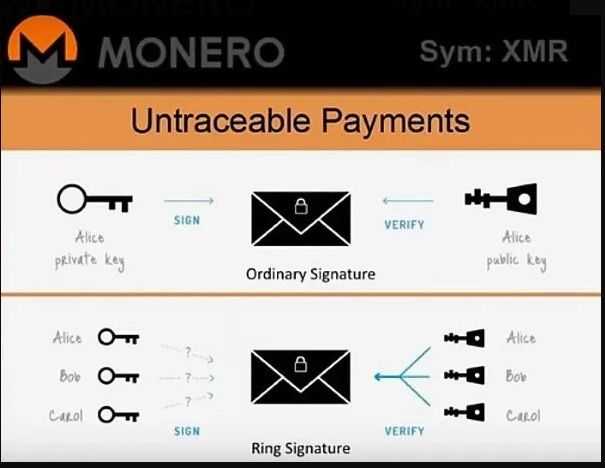
What are the Main Features and Benefits of Monero and Bitcoin?
The main features of Bitcoin and Monero are quite similar, with both valuing their cypherpunk roots, robust security and commitment to Proof of Work consensus mechanisms. If privacy and peer-to-peer transactions are your thing, Monero is typically the preferred choice, but for users looking for long-term investment potential with value accrual, deep liquidity and recognition, Bitcoin still rules the roost.
Bitcoin still maintains an element of privacy as wallet addresses are difficult to link to people’s personal identities, and as such, maintains its pseudonymous features. However, it’s important to note that Bitcoin maintains an open and fully transparent ledger that dates back to the genesis block of when Bitcoin first launched. Consequently, if a wallet can be linked to an individual, it’s possible to track all their transactions in their wallets, see their movement of Bitcoin and see how much Bitcoin that individual owns.
This does not happen with Monero as privacy is what it was designed for. Wallet balances and transaction history are all kept secret and private for user’s transactions. Privacy is a human right and, in my opinion, it’s a shame that this level of privacy hasn’t been built into Bitcoin since its inception. That being said, the level of regulatory scrutiny that comes with Monero’s private transactions has most certainly hampered its user adoption, market cap, and overall acceptance in the crypto community.
As such, Monero is only ranked 26th place for market cap, has comparatively poor price action, and is regularly being de-listed and removed from exchanges.
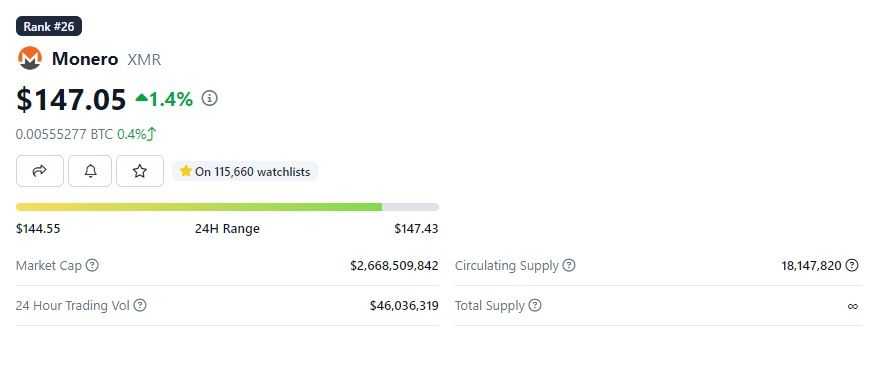
Let’s take a look at the broader features that Bitcoin and Monero have to offer.
Bitcoin’s features can be divided into 5 key points:
- Transparency: Bitcoin's blockchain is public, allowing anyone to view transactions and addresses. While the transactions themselves are pseudonymous (linked to wallet addresses rather than real identities), the transparency can be seen as a benefit for some use cases, such as financial transparency and auditability. This helps keep regulators on the side.
- Store of Value: Bitcoin is often referred to as "digital gold" and is considered a store of value, akin to precious metals like gold. Its limited supply (21 million coins) and deflationary nature make it attractive for long-term investment.
- Network Security: Bitcoin has the largest and most secure blockchain network in terms of hash power, making it highly resistant to attacks such as a 51% attack where a malicious actor would seek to gain over 50% of the hash rate and control the chain (assuming nodes agreed).
- Liquidity: Bitcoin is widely accepted and traded on numerous exchanges, making it highly liquid and easy to buy and sell all over the world.
- Recognition: Bitcoin is the first cryptocurrency and enjoys widespread recognition and adoption. Most people will have a vague understanding of what Bitcoin is in 2023.
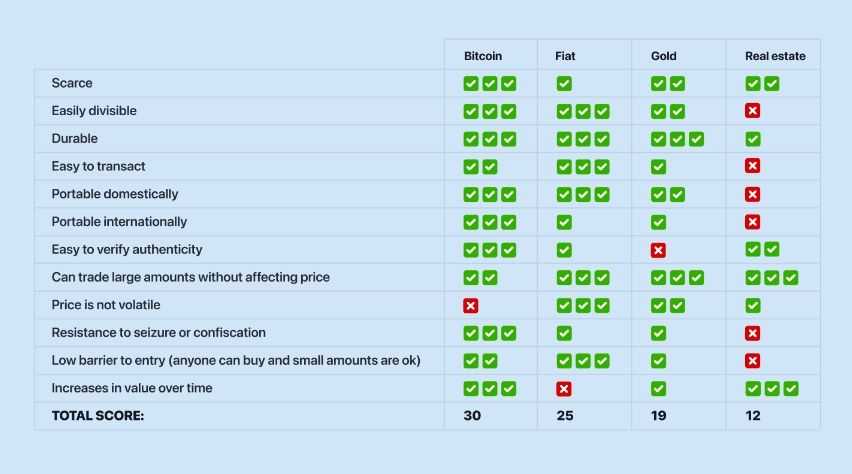
Monero’s features can be divided into 5 key points:
- Privacy: Monero is designed with a primary focus on privacy. Transactions, wallet balances, and sender/receiver addresses are all obfuscated, making it nearly impossible to trace transactions and link them to real-world identities.
- Fungibility: Monero's privacy features ensure that all coins are interchangeable and have equal value. Unlike Bitcoin, where certain coins can be tainted due to their history (associated with illicit activities, for example), all Monero coins are fungible.
- Security: Monero uses advanced cryptographic techniques to ensure the privacy and security of transactions.
- Decentralization: Like Bitcoin, Monero is decentralized, but its emphasis on privacy makes it a compelling option for those who value financial autonomy.
- Community: Monero has a strong community that is dedicated to maintaining and improving its privacy features.
What are the Challenges Facing Monero and Bitcoin?
As with any cryptocurrency, they all suffer from some form of challenge as design choices that benefit one aspect of their chain (such as privacy), inevitably create another problem further down the line (regulatory scrutiny). It’s the yin and yang of all blockchains and is a constant theme in the blockchain industry. Some blockchains sacrifice decentralization for speed, others optimize for security at the cost of energy output and some favour cheap transactions at the expense of hardware costs.
The blockchain Holy Grail that satisfies all these needs definitely doesn’t exist yet. This problem is often referred to as the Blockchain Trilemma or Scalability Trilemma. It can be argued that it’s impossible to ever completely fulfil all needs without accepting some level of compromise along the way. With that in mind, let’s explore the unique challenges that Monero and Bitcoin are facing today.
Monero
- Regulatory Pressures and Exchange Delisting
One of the significant challenges facing Monero is the regulatory environment surrounding privacy coins. Governments and financial regulators in various countries have expressed concerns about the use of privacy coins for illegal activities, including money laundering and tax evasion.
These concerns have led to increased regulatory scrutiny and in some cases, forced cryptocurrency exchanges to delist Monero and other privacy coins. This delisting can limit Monero's accessibility and liquidity, making it harder for users to buy, trade and use the coin. This hampers adoption and reduces Monero’s chances of success in an already hyper-competitive crypto market.
- Blockchain Bloat and Centralization Risk
Monero's approach to privacy, particularly its use of ring signatures and confidential transactions, contributes to blockchain bloat. As more transactions occur, the size of the Monero blockchain grows, which poses several challenges:
- Resource Intensiveness: The Monero blockchain size is relatively large compared to its market capitalization. This makes it resource-intensive for individuals to run full nodes, especially in developing countries with limited bandwidth and storage capacity. This could lead to centralization of nodes, where only well-funded entities can afford to participate in the network fully. If we compare Monero to Bitcoin, Bitcoin’s blockchain is 539 gigabytes and Monero's is 159 gigabytes. This is problematic because Bitcoin's market cap is 195 times higher than Monero's, but Bitcoin's blockchain size is only 5 times bigger than Monero's.
- Long Sync Times: For new users who want to join the Monero network, syncing their wallet with the blockchain can take a long time due to its size. This can deter potential users and slow down the adoption of Monero.
- Network Scalability: As the blockchain continues to grow, scalability becomes a concern. It can lead to slower transaction times and higher fees, making Monero less efficient for everyday transactions.
To address these challenges, the Monero community has been actively exploring solutions such as "pruning" to reduce blockchain size and "bulletproofs" to make transactions more efficient. However, these solutions are still a work in progress.
- Price Volatility and Investor Reluctance
Monero, like many cryptocurrencies, experiences significant price volatility. Anyone in the cryptocurrency space is aware of this and is no stranger to volatility. However, as we often joke, volatility to the upside is welcomed and if you look at major cryptocurrencies such as Bitcoin and Ethereum, this price action is trending upwardly.
The same cannot be said for Monero, whose all-time high was 5 years ago. This can make investors hesitant to buy and hold the cryptocurrency for fear of losing value. The concern is this pitches Monero more as a currency that is “good to use” as a utility but perhaps not good to hold long-term as an investment.
Price stability is important for cryptocurrencies to function as a reliable means of exchange and store of value. Additionally, negative perceptions of Monero due to its privacy features may deter some investors and businesses from adopting it.
Overall, Monero faces several challenges, including regulatory pressures, blockchain bloat and price volatility. Overcoming these challenges will require ongoing development efforts, regulatory engagement and education to promote the benefits of privacy in the cryptocurrency space while addressing concerns about misuse.
Bitcoin
- Scalability Issues
Bitcoin's scalability problems primarily stem from its small block sizes and slow block times. The small block size limits the number of transactions that can be included in each block, resulting in network congestion during periods of high demand, leading to slower transaction confirmation times and higher fees. This makes Bitcoin less suitable for everyday transactions.
This constraint was initially imposed to maintain decentralization by enabling more individuals to run full nodes. However, it hampers the network's ability to handle a larger volume of transactions efficiently. Additionally, Bitcoin's slow block times, with new blocks added approximately every 10 minutes, can lead to delays in confirming transactions, making it less suitable for quick, everyday payments. These scalability challenges have prompted ongoing debates and the exploration of various solutions, such as the Lightning Network, to enhance Bitcoin's capacity and transaction throughput while preserving its decentralized nature.
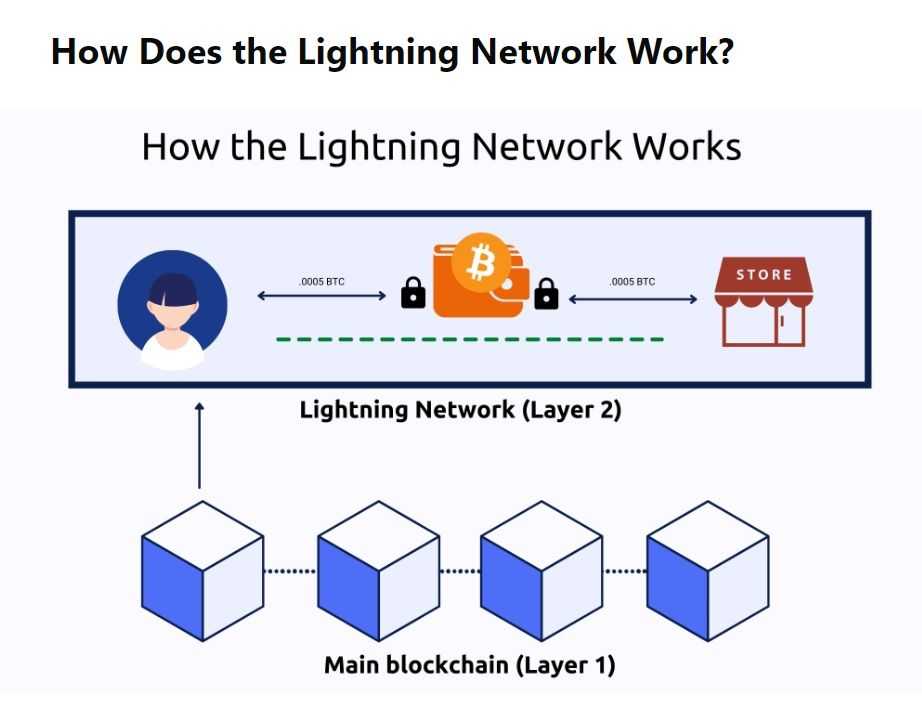
- Security Model Issues
Bitcoin's security model relies on miners to validate transactions and secure the network through PoW. While this has been effective in preventing double-spending and maintaining network integrity, it does have a rather large and looming problem that is often ignored or not thoroughly answered by the community.
Over time, Bitcoin's block rewards decrease by 50% roughly every 4 years (depending on blocks). Bitcoin's block subsidy and block rewards from mining are essential components of its decentralized monetary system. The block subsidy, also known as the "coinbase reward," is the initial reward given to miners for adding a new block to the blockchain. It started at 50 bitcoins per block when Bitcoin was created in 2009 and halves approximately every four years through a process called "halving." This subsidy serves as an incentive for miners to secure the network and validate transactions.
In addition to the block subsidy, miners also receive transaction fees paid by users for including their transactions in the block they mine. Therefore, miners will need to increasingly rely on transaction fees (rewards) as a source of income as block subsidy is reduced. This has raised concerns about the long-term sustainability of mining operations, especially if transaction fees do not provide sufficient incentives to secure the network.
- Centralized Mining
Bitcoin mining has become increasingly centralized due to the rise of large ASIC (Application-Specific Integrated Circuit) mining farms. These operations have significant computational power and can dominate the network's mining activities. This centralization raises concerns about the potential for collusion and manipulation, which goes against the decentralized ethos of Bitcoin.
- Geographic Centralization: Mining operations are often concentrated in regions with cheap electricity. This geographic centralization can pose risks, especially if regulatory changes or natural disasters impact these areas.
- 51% Attacks: The centralization of mining power could make the network susceptible to 51% attacks, where a single entity or coalition of miners could control more than half of the network's computational power, potentially enabling them to manipulate transactions or double-spend. In truth, this is a very unlikely scenario and there are numerous game theories that suggest the likelihood of this happening now is slim to none but it’s still a talking point and will remain a constant challenge for Bitcoin throughout its entire history.
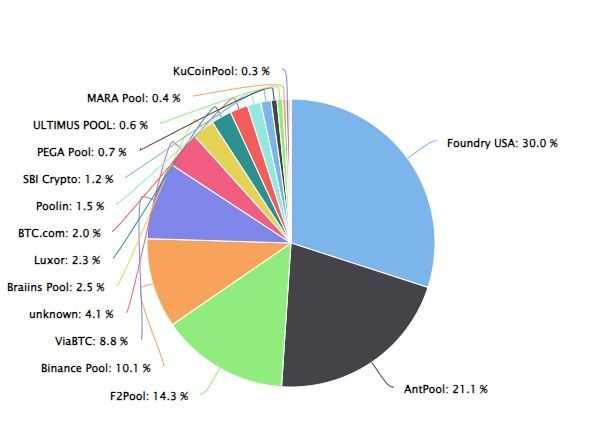
- Technological Upgrades
Implementing significant upgrades or changes to Bitcoin's protocol can be challenging due to the decentralized nature of the network. Achieving consensus among miners, developers and users can be a slow and contentious process. Not only this, but sometimes the upgrades can lead to potentially damaging outcomes. We saw this most recently with Taproot which “accidentally” allowed users to create Ordinal NFTs, which store the entirety of the inscribed data directly on-chain instead of simply linking a JPEG to a non-fungible token.
These Bitcoin NFTs have divided the Bitcoin community into two camps with Bitcoin maximalists shunning Ordinals from the outset, arguing that Bitcoin is a financial instrument. They believe that adding Ordinal NFTs into the mix only corrupts the network and dilutes Bitcoin's value. This argument largely stemmed from the idea that constant NFT inscriptions such as ordinals will create two problems:
- State bloat: Blocks containing larger amounts of data vs. financial transactions will increase node storage requirements. In turn, this will increase hardware costs and price people out of the market, causing centralization.
- Hype and speculation will create an increase in on-chain activity which will cause fee spikes. This will make transactions prohibitively expensive for people in developing nations who want to use Bitcoin for financial transactions.
Addressing these challenges is an ongoing effort within the Bitcoin community. Various proposals and developments, such as the Lightning Network for scalability and efforts to improve mining decentralization, aim to make Bitcoin more robust and adaptable in the face of these challenges. However, finding consensus on these changes remains a complex and sometimes contentious process within the Bitcoin ecosystem.
How Monero and Bitcoin Work
Monero and Bitcoin are both cryptocurrencies that utilize cryptography and blockchain technology, but they have different goals and approaches. Here's how they use these technologies to achieve their respective objectives:
Bitcoin
- Cryptography for Security: Bitcoin uses cryptographic techniques to secure transactions and control the creation of new units. Public-key cryptography is used to generate wallet addresses, sign transactions, and ensure the privacy and security of users.
- Blockchain Technology: Bitcoin's blockchain is a decentralized ledger that records all transactions ever made with the cryptocurrency. It uses a consensus mechanism called Proof of Work (PoW) to validate and add new transactions to the blockchain. Miners solve complex mathematical puzzles to confirm transactions and receive rewards in the form of newly created bitcoins.
- Transparency and Pseudonymity: Bitcoin's blockchain is transparent, meaning that anyone can view all transaction history. However, users are pseudonymous, as transactions are recorded using wallet addresses rather than personal information. This provides a degree of privacy but does not guarantee complete anonymity.
- Decentralization: Bitcoin operates on a decentralized network of nodes (computers) that validate and store the blockchain. This decentralization makes it resistant to censorship and control by any single entity.
- Digital Gold and Store of Value: Bitcoin's primary goal is to serve as a digital alternative to traditional currencies and a store of value. It aims to provide a secure and censorship-resistant means of transferring and storing wealth.
Monero
- Cryptography for Privacy: Monero places a strong emphasis on privacy and uses advanced cryptographic techniques like ring signatures and stealth addresses to obscure transaction details. Ring signatures mix the sender's transaction with several others, making it difficult to trace the origin. Stealth addresses hide the recipient's address.
- Blockchain Technology: Like Bitcoin, Monero uses a blockchain, but it differs in terms of privacy features. Transactions are still recorded on a public ledger, but the details are obfuscated, providing a higher level of privacy.
- Enhanced Anonymity: Monero's primary goal is to provide enhanced anonymity and fungibility. It aims to make every Monero coin interchangeable, so one coin is indistinguishable from another. This is essential for fungibility, as it ensures that all coins have equal value regardless of their history.
- Decentralization: Monero also operates on a decentralized network of nodes, similar to Bitcoin, to prevent central control and censorship.
While both Bitcoin and Monero use cryptography and blockchain technology, they have different goals. Bitcoin focuses on providing a decentralized, transparent, and secure means of transferring and storing value, whereas Monero prioritizes privacy and fungibility, aiming to make transactions as anonymous and indistinguishable as possible.
What Are The Key Components of Monero’s and Bitcoin’s Protocols?
Monero is renowned for its privacy-centric design. Bitcoin, in contrast, prioritizes transparency over privacy. Let's explore in detail.
Monero
Monero employs several privacy-enhancing technologies. One of the central features is ring signatures, which obscure the true sender of a transaction. In a ring signature, multiple possible signers are mixed together, making it computationally infeasible to determine which one is the actual sender. This obfuscates the sender's identity effectively.
Another critical component is stealth addresses. When a recipient provides a stealth address, it ensures that incoming transactions are only visible to the intended recipient. This mechanism greatly enhances privacy by making it extremely difficult for third parties to link incoming transactions to specific addresses or individuals.
Ring Confidential Transactions (RingCT) is yet another significant advancement in Monero's protocol. RingCT hides the transaction amounts while ensuring that the sum of inputs equals the sum of outputs, maintaining the integrity of the transaction while obfuscating the financial data.
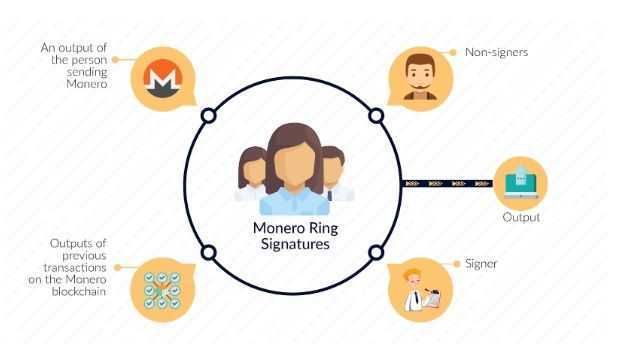
To improve efficiency and reduce transaction size and costs, Monero has implemented Bulletproofs, which are cryptographic proofs. Bulletproofs enable the verification of transactions with lower computational overhead, making Monero more scalable and cost-effective.
Monero is known for its strong focus on privacy, but one area where it could be improved is the way transactions are broadcast to the network. Previously, Monero transactions were relayed through a system called "Clearnet," which could potentially expose some information about the sender's IP address and transaction details.
With the implementation of Kovri, this issue has been addressed by implementing an overlay network that would hide the IP addresses of Monero users when they send transactions. In simple terms, it would make it even harder for anyone to trace the origin of a Monero transaction back to an individual user. This added layer of privacy enhances Monero's existing privacy features and makes it even more difficult for anyone to track or monitor transactions.
To learn more about the Kovri upgrade, head over to our dedicated article.
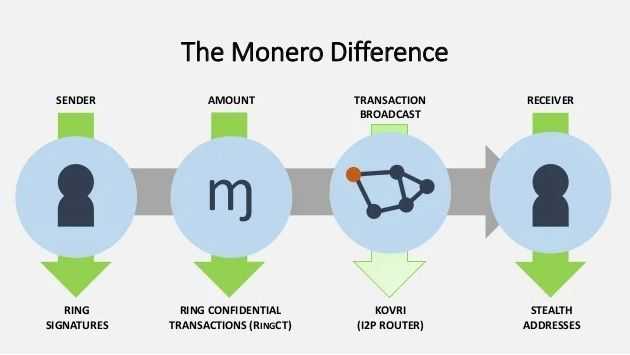
Lastly, Monero offers two further tools to ensure privacy for its users:
- View Key: Monero users have the option to share a view key with auditors or third parties, allowing them to verify transactions without compromising the user's privacy. This feature is known as "selective transparency."
- Dynamic Block Size: Monero adjusts its block size limit to accommodate transaction volume, reducing the risk of deanonymization due to congested blocks.
That’s Monero covered. Now let’s take a look at Bitcoin’s key components.
Bitcoin
While transactions on the Bitcoin blockchain are pseudonymous (not directly tied to real-world identities), transaction details, including sender, receiver and amount, are visible to anyone who examines the public ledger.
One notable upgrade in Bitcoin's protocol is Segregated Witness (SegWit). SegWit separates transaction signature data from the transaction data, reducing the size of transactions. It also fixes certain transaction malleability issues and lays the foundation for further scalability solutions.
To address scaling concerns, there’s the Lightning Network, a second-layer solution built on top of Bitcoin's blockchain. It addresses Bitcoin's scalability issues by enabling fast and low-cost off-chain transactions. By conducting transactions off the main blockchain and settling the net result on-chain, the Lightning Network reduces congestion and minimizes transaction fees.
More recently, Bitcoin implemented Taproot, which enhances both privacy and flexibility. Taproot allows multiple complex conditions to be hidden behind a single public key, making smart contract transactions appear more like standard Bitcoin transactions. This improves the privacy of Bitcoin's smart contract functionality.
Monero vs. Bitcoin: Real-Life Use Cases
When it comes to adoption and real-life use cases, Bitcoin and Monero face their own unique challenges.
Bitcoin
Bitcoin is more widely adopted than Monero, with more users, wallets and merchant adoption and is ranked 1st place with over 8,000 companies that accept Bitcoin, according to Cryptwerk.
Some notable big companies include:
- Microsoft
- Overstock
- Home Depot
- Whole Foods
- NewEgg
And that’s just large US-based companies!
Bitcoin is likely more successful than Monero at garnering merchant adoption due to five key things:
- Numerous Wallet Options: There are a wide variety of Bitcoin wallets available, catering to different user preferences, from mobile wallets for convenience to hardware wallets for enhanced security.
- Network Resilience: Bitcoin has shown resilience to various market challenges and regulatory pressures, maintaining its position as a leading digital asset.
- Global Accessibility: Bitcoin is accessible to anyone with an internet connection, providing financial services to unbanked and underbanked populations around the world.
- Growing Institutional Interest: Increasing numbers of institutional investors and companies are investing in and integrating Bitcoin into their financial strategies, adding to its credibility.
- Lightning Network: The Lightning Network is a Layer 2 solution built on top of Bitcoin's blockchain. It enables fast and cheap transactions, making micropayments and daily transactions more feasible.
Monero
According to data from Cryptwerk, Monero is ranked 9th for businesses/companies that accept Monero for payment. Monero’s key strength is its focus on privacy. When making a payment in Monero, you can be safe in the knowledge that no one can view how much Monero you have stored in your wallet which is good for personal safety.
The downside to Monero’s privacy features is it can often be tarnished with the “illegal” or “illicit” brand, and therefore act as a deterrent for merchants.
Monero’s privacy features will always make it struggle in two key areas:
Public Perception
- Stigma and Misconceptions: Due to its association with anonymity and privacy, Monero has garnered a reputation as the cryptocurrency of choice for those looking to engage in illicit activities. This perception can deter legitimate merchants from accepting Monero as a form of payment.
- Concerns about Reputation: Businesses may worry that accepting Monero could lead to reputational damage or regulatory scrutiny, as they could be seen as facilitating illicit transactions, even if they have no involvement in such activities.
Regulatory Challenges
- Government Scrutiny: Some governments and regulatory bodies are concerned about the potential for cryptocurrencies like Monero to be used for illegal purposes. This has led to discussions and debates around regulating or even banning privacy-focused cryptocurrencies.
- Compliance Burden: For merchants, compliance with anti-money laundering (AML) and know-your-customer (KYC) regulations can be challenging when dealing with cryptocurrencies like Monero, as they offer a higher degree of anonymity.
Bitcoin and Monero each present their own distinct set of challenges and advantages in terms of real-life use cases.
Bitcoin boasts wider adoption, with numerous high-profile companies accepting it as a form of payment, thanks to its diverse wallet options, global accessibility, and growing institutional interest. The Lightning Network also enhances its utility for everyday transactions.
On the other hand, Monero's primary strength lies in its robust privacy features, which ensure transaction confidentiality and personal safety. However, these very features contribute to its public perception problem, often associated with illicit activities, and regulatory challenges due to concerns about anonymity and compliance.
Ultimately, the choice between Bitcoin and Monero for real-life use cases depends on the specific needs and priorities of individuals and businesses.
Conclusion
Monero and Bitcoin represent two distinct approaches to cryptocurrency with their own unique sets of features and benefits. Bitcoin, as the pioneer of the cryptocurrency space, offers recognition, liquidity and a store of value akin to digital gold. Its transparency, while providing financial traceability, also allows for auditability and regulatory compliance.
On the other hand, Monero prioritizes privacy above all else, providing users with unparalleled anonymity and transaction confidentiality. Its fungibility ensures that all coins are equal, reducing concerns about tainted funds. Monero's community actively supports its mission of financial privacy and security.
The choice between Monero and Bitcoin ultimately hinges on individual preferences and specific use cases. Bitcoin may be more suitable for those seeking a digital store of value, while Monero is favoured by individuals who prioritize privacy, security and fungibility in their cryptocurrency transactions. Both cryptocurrencies have made significant contributions to the world of digital finance and their coexistence continues to offer users a diverse range of options in the evolving landscape of decentralized currencies.
Despite the allure of flashy tokens and innovative features in the crypto world, Bitcoin and Monero remain resolute in their commitment to time-tested principles. They may not always be the trendiest or most technologically advanced, but they are a reminder that the core ideals of cryptocurrency transcend mere hype and speculation. As the crypto landscape continues to evolve, Bitcoin and Monero serve as enduring symbols of the OG era, a testament to the notion that sometimes, the old ways are indeed the best ways, especially when it comes to preserving the values that ignited the cryptocurrency revolution.
In the end, while Bitcoin and Monero each offer their unique strengths and trade-offs, they share a common heritage of privacy, security, and decentralization, showcasing the resilience of the principles that continue to shape the world of cryptocurrencies.
Frequently Asked Questions
Yes, there are numerous countries where Bitcoin and Monero are banned. However, countries change their mind often and not all bans are permanent. Sometimes, when a country is deciding what regulation to put in place it will blanket ban cryptocurrency until the regulation is put in place.
Bitcoin, yes. Monero, no.
Bitcoin transactions are traceable because they're recorded on a public ledger, the blockchain, allowing anyone to monitor the flow of funds. While Bitcoin addresses themselves don't reveal user identities, de-anonymization becomes possible when users interact with exchanges and services that require identity verification.
Monero, in contrast, emphasizes privacy. Its transactions employ advanced techniques like ring signatures and confidential transactions, obscuring the sender, receiver, and transaction amount by default. This robust privacy makes tracing Monero transactions considerably more challenging for both law enforcement and hackers. However, it's important to note that no system is entirely immune to investigation, and user practices and external factors can still influence the degree of privacy achieved.
The choice between Bitcoin and Monero ultimately comes down to personal preference and specific goals. For investors seeking a well-established and widely adopted cryptocurrency, Bitcoin may be the better choice. However, it lacks privacy features, making it less suitable for those who prioritize anonymity.
On the other hand, Monero offers superior privacy technology, making it ideal for individuals who highly value their privacy and seek to keep their transactions confidential. It provides stronger privacy features compared to Bitcoin.
In summary, for investment purposes, Bitcoin is often favoured, but if privacy is a top priority, Monero's advanced privacy features make it the better option.
Bitcoin has been widely criticized for its environmental impact. Its mining process consumes a substantial amount of computational power and, consequently, energy.
Monero, on the other hand, utilizes a different consensus algorithm which is designed to be more energy-efficient compared to Bitcoin's Proof of Work. Monero is optimized for CPU mining, which levels the playing field by allowing people to mine Monero using standard computer hardware, reducing the energy requirements associated with specialized mining rigs used in Bitcoin mining.
That being said, one argument in favour of Bitcoin's environmental friendliness is the concept of "stranded energy." This refers to energy sources that are underutilized or wasted due to geographical or logistical constraints. Bitcoin mining can be conducted in regions with abundant but otherwise unused or excess energy, such as hydroelectric power plants in remote areas or flared natural gas at oil drilling sites. By setting up mining operations in these locations, Bitcoin miners can make use of energy that would otherwise go to waste, increasing overall energy efficiency.
Bitcoin has also been praised for enabling people around the world to tap into sustainable energy systems. Mining Bitcoin can provide an economic incentive to invest in renewable energy sources like solar, wind, or hydroelectric power. Miners can set up operations in areas with access to clean and renewable energy sources, thus contributing to the adoption and development of sustainable energy infrastructure.
In summary, Monero is generally considered to be more environmentally friendly and energy-efficient than Bitcoin due to its use of the RandomX consensus algorithm. Bitcoin, on the other hand, has the potential to leverage stranded energy sources and promote sustainable energy adoption, but its overall energy consumption remains a contentious issue in the ongoing debate about cryptocurrencies and the environment.
Disclaimer: These are the writer’s opinions and should not be considered investment advice. Readers should do their own research.


